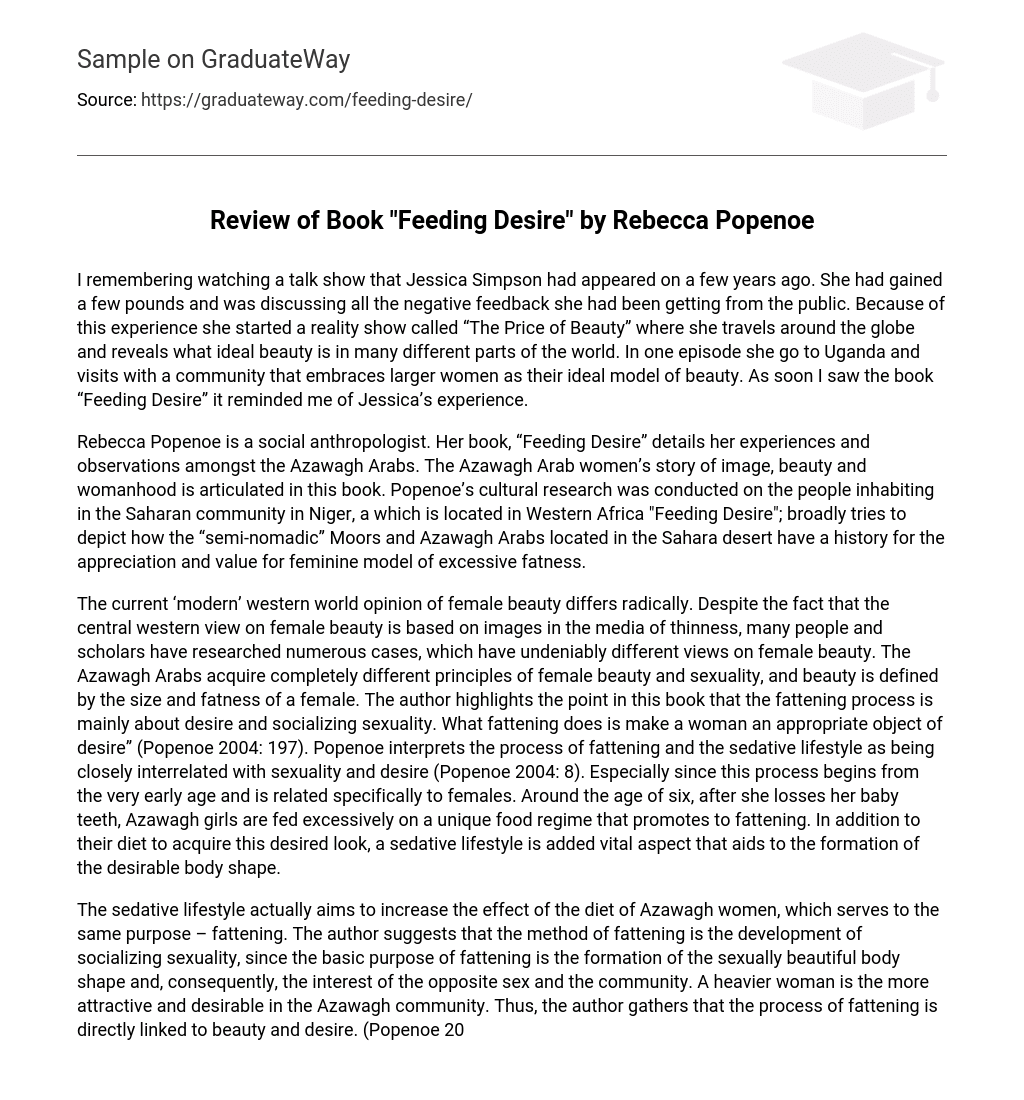I remembering watching a talk show that Jessica Simpson had appeared on a few years ago. She had gained a few pounds and was discussing all the negative feedback she had been getting from the public. Because of this experience she started a reality show called “The Price of Beauty” where she travels around the globe and reveals what ideal beauty is in many different parts of the world. In one episode she go to Uganda and visits with a community that embraces larger women as their ideal model of beauty. As soon I saw the book “Feeding Desire” it reminded me of Jessica’s experience.
Rebecca Popenoe is a social anthropologist. Her book, “Feeding Desire” details her experiences and observations amongst the Azawagh Arabs. The Azawagh Arab women’s story of image, beauty and womanhood is articulated in this book. Popenoe’s cultural research was conducted on the people inhabiting in the Saharan community in Niger, a which is located in Western Africa “Feeding Desire”; broadly tries to depict how the “semi-nomadic” Moors and Azawagh Arabs located in the Sahara desert have a history for the appreciation and value for feminine model of excessive fatness.
The current ‘modern’ western world opinion of female beauty differs radically. Despite the fact that the central western view on female beauty is based on images in the media of thinness, many people and scholars have researched numerous cases, which have undeniably different views on female beauty. The Azawagh Arabs acquire completely different principles of female beauty and sexuality, and beauty is defined by the size and fatness of a female. The author highlights the point in this book that the fattening process is mainly about desire and socializing sexuality. What fattening does is make a woman an appropriate object of desire” (Popenoe 2004: 197). Popenoe interprets the process of fattening and the sedative lifestyle as being closely interrelated with sexuality and desire (Popenoe 2004: 8). Especially since this process begins from the very early age and is related specifically to females. Around the age of six, after she losses her baby teeth, Azawagh girls are fed excessively on a unique food regime that promotes to fattening. In addition to their diet to acquire this desired look, a sedative lifestyle is added vital aspect that aids to the formation of the desirable body shape.
The sedative lifestyle actually aims to increase the effect of the diet of Azawagh women, which serves to the same purpose – fattening. The author suggests that the method of fattening is the development of socializing sexuality, since the basic purpose of fattening is the formation of the sexually beautiful body shape and, consequently, the interest of the opposite sex and the community. A heavier woman is the more attractive and desirable in the Azawagh community. Thus, the author gathers that the process of fattening is directly linked to beauty and desire. (Popenoe 2004: 48) Fattening also symbolizes a woman of a desirable social status.
All though all Azawagh women are to fatten, it is mainly those from a well off or wealth family that can fatten their daughters, wives or sister. A woman’s social status is elevated, being notable by her fatness, but so is the social status of the man or husband. The practice of fattening is advantageous in a way not just to the social status of women, but furthermore and mostly to the social status of men. Clearly, on choosing a heavy wife, an Azawagh man can stress his social status and wealth. Having a large wife will indicate that a husband can marry the woman from an upper class and can maintain a somewhat good standard of life.
As mentioned earlier the fattening process begins at the early age, therefore a family in which a girl grows should possess significant wealth and material resources to feed the girl since, traditionally Azawagh families are normally large. Therefore, excessive feeding of girls and women is directly reliant on on the social situation of the family. Poor families can hardly afford feeding girls and the “richer” family will have healthier outcomes, since girls that grow in rich family will evidently have better nutrition, and poor families wont be able to afford a proper fattening diet.
For an Azawagh man having a large wife indicates that man is of wealth or at least has enough means to acquire a voluptuous woman, which in essence means he will me able to take and care for her and the family. This also indicates a somewhat happy or content life as it shows in the woman’s size. Being of a particular high status was not only admirable by those in the community but in turn it would also indicate and symbolize a type of class/cast in the community. These trademarks assist to enhance and secure future marriages. In such a context, the process of fattening has little in common with sexuality but gain with what is desirable, what is appealing in life. Fattening is appealing to all in the Azawagh society, men, women, and role models for the younger girls and boys. Fattening can be described as a sort of status quo. Popenoe (2004: 197) Young Azawagh girls at an early age foresee fattening as their soon to be future. Historically fattening is very much a part of the Moors and Azawagh culture. A way of life that will actually open many “doors” for females and her family if granted the opportunity to fatten and become an ultimate model of desire. “Fattening speaks directly to this challenge” (Popenoe 2004: 197)
References
Popenoe, Rebecca. “Feeding Desire: Fatness, Beauty, and Sexuality among a Saharan People” (2004) Alley, Kristie http://www.bbwcupid.com/blog/20-famous-fat-quotes





